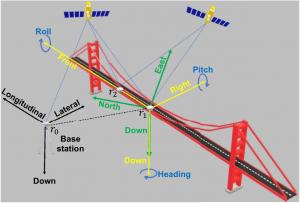Bridges that talk: GNSS reveals hidden structural shifts
GA, UNITED STATES, August 1, 2025 /EINPresswire.com/ -- Bridges endure constant environmental and operational stresses—some visible, others imperceptible. This study introduces an innovative Global Navigation Satellite System (GNSS)-based system that simultaneously tracks both displacement and structural attitude, such as pitch and heading. Unlike traditional systems that only measure movement, this integrated approach provides a more complete picture of how bridges respond to real-world forces like wind and temperature shifts. Through real-time, high-precision data collection and analysis, the method enables earlier detection of structural anomalies, paving the way for safer and smarter infrastructure management.
Long-span bridges are engineering marvels—but they also face constant challenges from wind, traffic, and thermal expansion. Monitoring these dynamic responses has long relied on displacement data alone, often missing subtle changes in orientation that precede more visible damage. Emerging technologies such as Global Navigation Satellite System (GNSS) have enhanced position tracking, but integrating attitude determination—particularly in real time—remains difficult. Existing methods either separate displacement and attitude estimation or lack the precision needed for early warnings. Due to these challenges, there is a critical need to develop integrated systems that can monitor both displacement and attitude for a fuller understanding of structural behavior.
A research team led by Southeast University has developed a cutting-edge GNSS-based method to monitor both displacement and attitude of long-span bridges with remarkable accuracy. Published (DOI: 10.1186/s43020-025-00174-9) in Satellite Navigation in July 2025, the study evaluates the system on the Forth Road Bridge in Scotland. The approach combines data from multiple GNSS antennas and employs the Unscented Kalman Filter (UKF) to track real-time structural changes under varying environmental conditions, including strong winds and temperature shifts.
This new method, termed Integrated Displacement and Attitude Determination (IDAD), uses GNSS data from multiple antennas placed along the bridge to capture both movement and orientation. Unlike traditional two-step methods, IDAD uses a unified model powered by UKF, allowing it to resolve GNSS ambiguities and fuse displacement and attitude data in real time. The system achieved sub-centimeter displacement accuracy (0.004–0.006 m horizontally, 0.008–0.010 m vertically) and micro-degree attitude precision (pitch 0.0013°, heading 0.0004°) using baselines as long as 2 km. Field testing during winter storms showed the system's ability to detect heading and pitch variations in response to lateral wind forces and temperature changes. These small yet meaningful shifts provide early signs of structural strain that might otherwise go unnoticed. Importantly, the IDAD approach preserves the cross-correlation between displacement and attitude, offering a new lens to interpret bridge health dynamics holistically.
“By integrating displacement and attitude into one estimation framework, we're capturing a dimension of structural behavior that has been largely overlooked,” says Professor Xiaolin Meng, senior author of the study. “This level of insight allows us to better understand how bridges breathe and bend—vital knowledge for proactive maintenance and public safety.”
This integrated GNSS approach signals a new era in structural health monitoring. Beyond bridges, it could be adapted for skyscrapers, dams, and offshore platforms—anywhere subtle shifts can accumulate into serious risks. Its ability to deliver accurate, real-time data without relying on inertial sensors also simplifies deployment and lowers cost. Most critically, the method lays the foundation for future systems combining GNSS with IMUs in tightly coupled configurations for structural health monitoring, potentially enabling high-frequency monitoring in challenging environments. With infrastructure aging globally, the adoption of such multidimensional monitoring systems may be key to building safer, smarter cities.
DOI
10.1186/s43020-025-00174-9
Original Source URL
https://doi.org/10.1186/s43020-025-00174-9
Funding information
This research is funded by the project “BeiDou/GNSS Multi-Sourced Data Fusion Theory and Digital Twinning Method for Real-Time and Condition Diagnosis of Large-Span Bridges” from the National Natural Science Foundation of China (No. 42430711), and supported by “the Fundamental Research Funds for the Central Universities” (No. 2242025K20010).
Lucy Wang
BioDesign Research
email us here
Legal Disclaimer:
EIN Presswire provides this news content "as is" without warranty of any kind. We do not accept any responsibility or liability for the accuracy, content, images, videos, licenses, completeness, legality, or reliability of the information contained in this article. If you have any complaints or copyright issues related to this article, kindly contact the author above.

